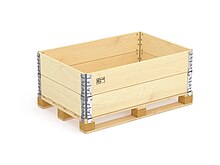Wooden frame
Wooden stacking frames serve as packaging , conveying aids and storage aids for numerous packaged goods . This packaging solution is used together with the classic wooden pallet or special pallets and serves as an alternative to the classic wooden boxes.
The main difference to the wooden boxes is the possibility of folding the stacking frames together when not in use.
construction
A wooden stacking frame consists of four or six panels and four or six metal hinges that hold the panels together. Placed on pallets and, if necessary, stacked, they form stable packaging.
The hinges allow the frames to fold together. Compared to the wooden boxes, more than 80% of the space can be saved. Numerous sizes are produced depending on the packaged goods and filling quantity. Hinges can be adjusted, for example, to be able to open one of the sides for access to stored goods.
Standard wooden stacking frames are made from solid boards . There are also stacking frames made of plywood , OSB or plastic.
standardization
Standard wooden stacking frames are made in four heights: 100, 200, 300 and 400 mm. By stacking these heights, the packaging can be adapted to the packaged goods.
Three standard sizes are produced in the floor plan: 600 × 800, 800 × 1200 and 1000 × 1200 mm. These sizes are suitable for the majority of standard pallets.
Risk avoidance
Although the majority of manufacturers adhere to the standardized sizes, there may be differences depending on the manufacturing technology, which can cause safety risks when used. Therefore, frames from different manufacturers should not be stacked on top of each other.
Logistic importance
By using wooden stacking frames, types of products that are normally packed in classic wooden boxes can be stored and transported on transport pallets. Brittle products can be stored on specially adapted pallets.
Wooden stacking frames enable multi-level storage of goods on pallets, on shelves or without shelves. If high quality wooden stacking frames are used correctly, space can be saved in both the warehouse and during transport. They are quick and easy to use, and access to the stored goods is quicker and easier.
history
Together with the growing popularity of the container transport solution , the use of classic wooden pallets has been promoted. In order to be able to use pallets for other types of products, wooden stacking frames were brought onto the market.
Since space-saving solutions are important in logistics companies , the popularity of these stacking frames has grown significantly over the last 20 years. Around 20 million wooden stacking frames are manufactured worldwide every year.
See also
- ISPM 15 , regulation of wooden packaging materials in international trade
literature
- Jolyon Drury, Peter Falconer, George Heery: Buildings for Industrial Storage and Distribution. Routledge, London / New York 2003, ISBN 1-136-42419-9 , p. 136, ( books.google.com ).
Web links
- ISPM 15 (PDF) Regulation of wooden packaging material in international trade.
